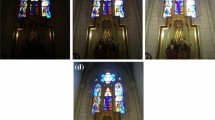Abstract
Affine transformation is widely used in image processing. Recently, it is recommended by MPEG-4 for video motion compensation. This paper presents a novel low power parallel architecture for texture warping using affine transformation (AT). The architecture uses a novel multiplication-free algorithm that employs the algebraic properties of the AT. Low power has been achieved at different levels of the design. At the algorithmic level, replacing multiplication operations with bit shifting saves the power and delay of using a multiplier. At the architecture level, low power is achieved by using parallel computational units, where the latency constraints and/or the operating latency can be reduced. At the circuit level, using low power building blocks (such as low power adders) contributes to the power savings. The proposed architecture is used as a computational kernel in video object coders. It is compatible with MPEG-4 and VRML standards. The architecture has been prototyped in 0.6 μm CMOS technology with three layers of metal. The performance of the proposed architecture shows that it can be used in mobile and handheld applications.
Similar content being viewed by others
References
M.F. Goodchild, “Geocoding and Geosampling,” in Spatial Statistics and Models, G.L. Gaile and C.J. Willmott (Eds.), Reidel Publishing Company, Dordrecht, Holland, 1984, pp. 33-53.
P.J.L. van Beek, A.M. Tekalp, and A. Puri, “2D Mesh Geometry and Motion Compression for Efficient Object-Based Video Representation,” Int. Conf. On Image Processing '97, Santa Barbara, CA, Oct. 1997.
S. Brofferio and F. Rocca, “Interframe Redundancy Reduction of Video Signals Generated by Translating Objects,” IEEE Trans. Commun. vol. Com-25, 1977, pp. 448-455.
A.M. Tekalp, P.J.L. van Beek, C. Toklu, and B. Gunsel “2D Mesh-Based Visual Object Representation for Interactive Synthetic/Natural Video,” in Proc. of the IEEE (special issue), vol. 86,no. 6, 1998, pp. 1029-1051.
K.J. Ray Liu et al. “Algorithm-Based Low Power and High-Performance Multimedia Signal Processing,” in Proc. of IEEE, vol. 86,no. 6, 1998, pp. 1155-1202.
R.M. Haralick, “Automatic Remote Sensor Image Processing,” in Topics in Applied Physics, vol. 11: Digital Picture Analysis. New York: Springer-Verlag, 1976, pp. 5-63.
G. Wolberg, Digital Image Warping, Los Alamitos, CA: Computer Society Press, 1990.
G.J. Holzmann, Beyond Photography-The Digital Darkroom, Englewood Cliffs, NJ: Prentice-Hall, 1998.
H. Bruzewitz, “Motion Compensation with Triangles,” in Proc. 3rd Int. Conf. 64 kbit Coding of Moving Video, Rootterdam, The Netherlands, 1990.
G.J. Sullivan and R.L. Baker, “Motion Compensation for Video Compression Using Control Grid Interpolation,” in Proc. IEEE ICASSP, vol. 4, 1991, pp. 2713-2716.
Y. Nakaya and H. Harashima, “An Iterative Motion Estimation Method Using Triangular Patches for Motion Compensation,” in Proc. SPIE Visual Communications and Image Processing, vol. 1605, 1991, pp. 546-557.
Y. Nakaya and H. Harashima, “Motion Compensation Based on Spatial Transformations,” IEEE Trans. Circuits Syst. Video Technol., vol. 4, 1994, pp. 339-356.
J. Nieweglowski, T. Campbell, and P. Haavisto, “A Novel Video Coding Scheme Based on Temporal Prediction Using Digital Image Warping,” IEEE Trans. Consumer Electron., vol. 39, 1993, pp. 141-150.
C. Toklu, A. Erdem, M.I. Sezan, and A.M. Tekalp, “Tracking Motion and Intensity Variations Using Hierarchical 2-D Mesh Modeling for Synthetic Object Transfiguration,” Graphic Models and Image Processing, vol. 58, 1996, pp. 553-573.
A. Nosratinia, N. Mohsenian, M.T. Orchard, and B. Liu, “Interslice Coding of Magnetic Resonance Images Using Deformable Triangular Patches,” in Proc. IEEE ICIP, vol. 2, Austin, TX, 1994, pp. 898-892.
A. Nosratinia, N. Mohsenian, M.T. Orchard, and B. Liu, “Interframe Coding of Magnetic Resonance Images,” IEEE Trans. Medical Imaging, vol. 15, 1996, pp. 639-647.
N. Mohsenian, A. Nosratinia, B. Liu, and M.T. Orchard, “Adaptive Entropy Constrained Transform Coding of Magnetic Resonance Image Sequences,” IEEE Trans. Nuclear Sci., vol. 42, 1995, pp. 2309-2316.
P.E. Eren, C. Toklu, and A.M. Tekalp, “Object-Based Manipulation and Composition Using 2D Meshes in VRML,” in Proc. IEEE Signal Processing 1st Workshop Multimedia Processing, Princeton, NJ, 1997, pp. 257-261.
A. Nosratinia, “New Kernels for Fast Mesh-Based Motion Estimation,” IEEE Trans. On Circuits and Syst. For Video Technol., vol. 11,no. 1, 2001, pp. 40-51.
C.L. Huang and C.Y. Hsu, “A New Motion Compensation Method for Image Sequence Coding Using Hierarchical Grid Interpolation,” IEEE Trans. Circuits Syst. Video Technol., vol. 4, 1994, pp. 42-52.
Author information
Authors and Affiliations
Rights and permissions
About this article
Cite this article
Badawy, W., Bayoumi, M. A Multiplication-Free Algorithm and A Parallel Architecture for Affine Transformation. The Journal of VLSI Signal Processing-Systems for Signal, Image, and Video Technology 31, 173–184 (2002). https://doi.org/10.1023/A:1015397423173
Published:
Issue Date:
DOI: https://doi.org/10.1023/A:1015397423173




